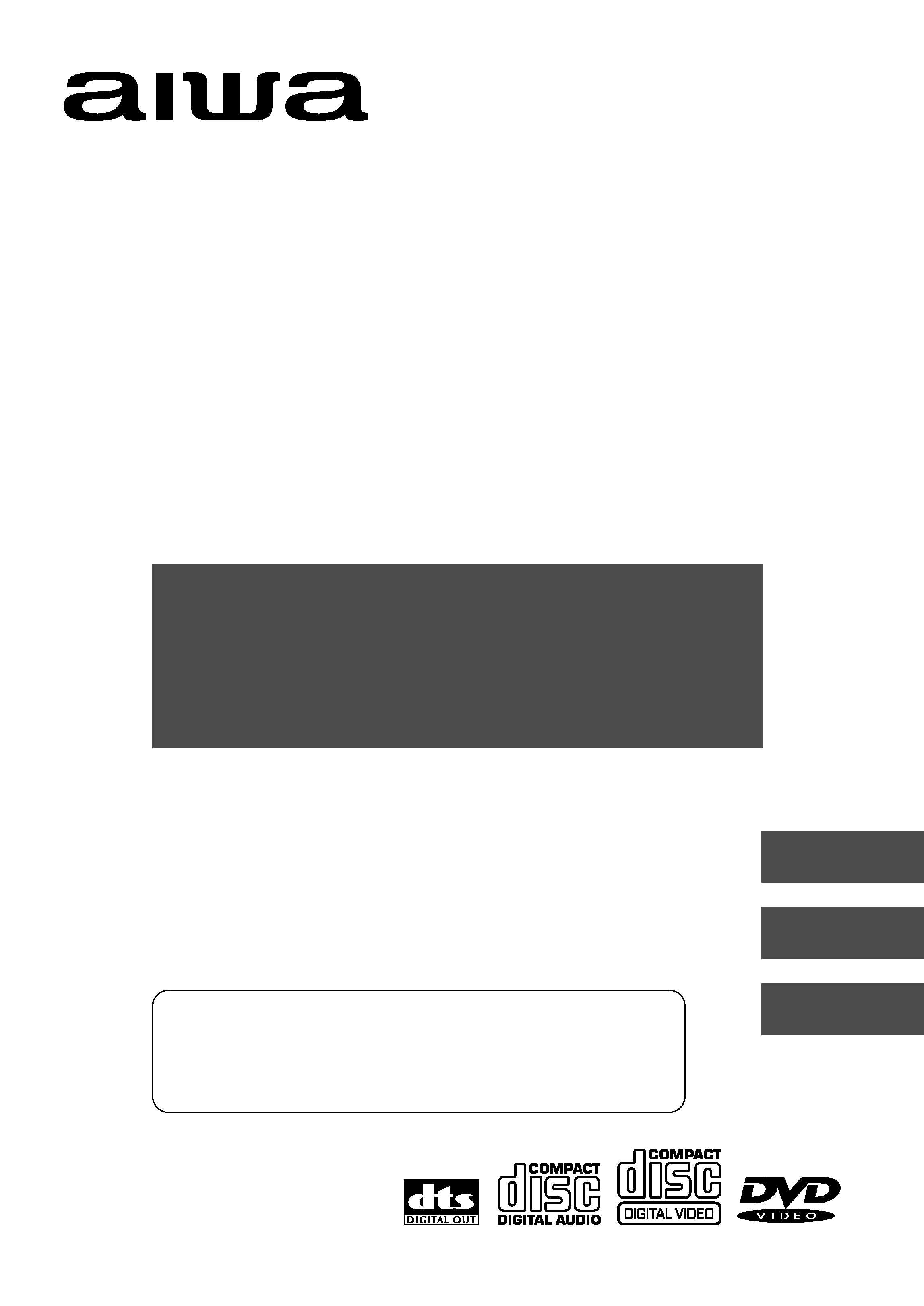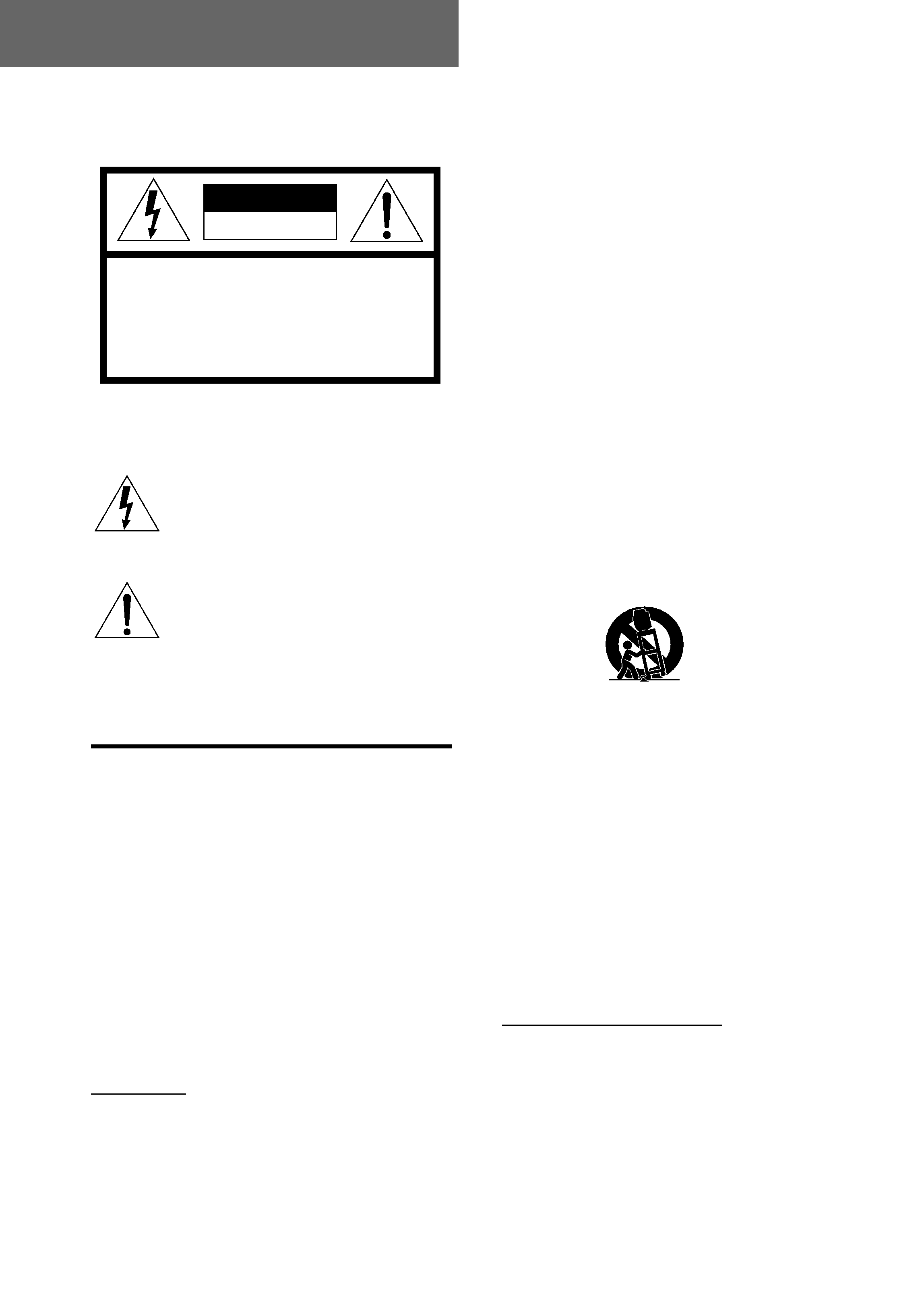
VX-F20DV1U
OPERATING INSTRUCTIONS
INSTRUCCIONES DE MANEJO
MODE D'EMPLOI
COLOR TELEVISION
TELEVISOR EN COLOR
TELEVISEUR COULEUR
ENGLISH
ESPAÑOL
For Assistance And Information
Call Toll Free 1-800-BUY-AIWA
(United States and Puerto Rico)
FRANÇAIS

ENGLISH
2
Warning
To reduce the risk of fire or electric shock, do
not expose this appliance to rain or moisture.
Explanation of Graphical Symbols
The lightning flash with arrowhead symbol
within an equilateral triangle, is intended to
alert the user to the presence of uninsulated
"dangerous voltage" within the products
enclosure that may be of sufficient
magnitude to constitute a risk of electric
shock to a person.
The exclamation point within an equilateral
triangle is intended to alert the user to the
presence of impor tant operating and
maintenance (servicing) instructions in the
literature accompanying the appliance.
IMPORTANT SAFETY
INSTRUCTIONS
Read the operating instructions carefully and
completely before operating the unit. Be sure to
keep the operating instructions for future reference.
All war nings and cautions in the operating
instructions and on the unit should be strictly
followed, as well as the safety suggestions below.
Warning
To prevent electric shock or other injuries, follow all
the safety instructions when installing, operating
and servicing the unit.
Installation
Attachments - Do not use attachments that have
not been recommended by the manufacturer
because doing so may result in the risk of fire,
electric shock or other injuries.
"CAUTION:TO REDUCE THE RISK OF
ELECTRIC SHOCK,
DO NOT REMOVE COVER (OR BACK).
NO USER-SERVICEABLE PARTS INSIDE.
REFER SERVICING TO QUALIFIED
SERVICE PERSONNEL."
CAUTION
RISK OF ELECTRIC SHOCK
DO NOT OPEN
Water and Moisture - Do not use this unit near
water - for example, near a bathtub, washbowl,
kitchen sink, or laundry tub, in a wet basement, or
near a swimming pool, and the like.
Heat - Do not use this unit near sources of heat,
including heating vents, stoves, or other appliances
that generate heat. It also should not be placed in
temperatures less than 5°C (41°F) or greater than
35°C (95°F ).
Mounting surface - Place the unit on a flat, even
surface.
Accessories - Do not place the unit on an unstable
cart, stand, tripod, bracket, or table. The unit may
fall causing serious injury to persons and serious
damage to the appliance. Use only with a cart,
stand, tripod, bracket, or table recommended by the
manufacture, or sold with the unit. When mounting
the appliance, follow the manufacturer's instructions.
When mounting the unit, use accessories
recommended by the manufacturer.
Portable cart - An appliance and cart combination
should be moved with care. Quick stops, excessive
force, and uneven surfaces may cause the
appliance and cart combination to overturn.
Ventilation - The unit should be situated with
adequate space around it so that proper heat
ventilation is assured. Allow 10 cm clearance from
the rear and the top of the unit, and 5 cm from the
each side.
Slots and openings in the cabinet and the back or
bottom are provided for ventilation, and to ensure
reliable operation of the unit and to protect it from
overheating, these openings must not be blocked
or covered. The openings should never be blocked
by placing the unit on a bed, sofa, rug or other
similar surface. (This unit should never be placed
near or over a radiator or heat register.) This unit
should not be placed in a built-in installation such
as a bookcase unless proper ventilation is provided.
Weight and heavy objects
The unit should be moved with care by two or more
people as the weight balance is not even. Do not
place heavy objects on the unit.
Object and Liquid Entry - Never push objects of
any kind into the unit through the cabinet slots
because they may come into contact with
dangerous voltage points or short-circuit parts and
cause fire or electric shock. Never spill liquid of any
kind on the unit. Do not put a vase or the like with
water inside on this unit.
ENGLISH
PORTABLE CART WARNING
S3126A

ENGLISH
3
ANTENNA LEAD IN WIRE
ANTENNA DISCHARGE
UNIT
(NEC SECTION 810-20)
GROUNDING
CONDUCTORS
(NEC SECTION 810-21)
GROUND CLAMPS
POWER SERVICE GROUNDING
ELECTRODE SYSTEM
(NEC ART 250 PART H)
NEC-NATIONAL ELECTRICAL CODE
ELECTRIC
SERVICE
EQUIPMENT
GROUND CLAMP
Antenna Grounding According to the National Electrical Cord
Lightning
For added protection during a lightning storm, or
when left unattended and unused for long periods
of time, unplug the unit from the wall outlet and
disconnect the antenna or cable system. This will
prevent damage to the unit due to lightning and
powerline surges.
Maintenance
Cleaning - Unplug the unit from the wall outlet
before cleaning. Do not use liquid cleaners or
aerosol cleaners. Use a damp cloth for cleaning.
Damage Requiring Service
Unplug the unit from the wall outlet and refer for
servicing to qualified service personnel under the
following conditions:
1) When the power cord or plug is damaged or
frayed.
2) If liquid has been spilled into the unit.
3) If the unit has been exposed to rain or water.
4) If the unit does not operate normally when
following the operating instructions. Adjust
only those controls that are covered by the
operating instructions because improper
adjustment of other controls may result in
damage to the unit and will often require
extensive work by a qualified technician to
restore the unit to normal operation.
5) If the unit has been dropped or the cabinet
has been damaged.
6) When the unit exhibits a distinct change in
performance - this indicates a need for service.
Do not attempt to service the unit yourself because
opening or removing covers may expose you to high
voltage or other hazards. Refer all servicing to
qualified service personnel.
Replacement Parts - When replacement parts are
required, be sure the service technician has used
replacement parts specified by the manufacturer
or having the same characteristics as the original
part. Unauthorized substitutions may result in fire,
electric shock or other hazards.
Safety Check - After completion of any service or
repairs to the unit, ask the service technician to
perform a safety check to ensure that the unit is in
proper operating condition.
Electric Power
Power Sources - This unit should be operated only
from the type of power source indicated on the
marking label. If you are not sure of the type of power
supply to your home, consult your appliance dealer
or local power company. To operate this unit on
batter y power, or other sources, refer to the
operating instructions.
Grounding or Polarization - This unit is provided
with a polarized alternating-current line plug (a plug
having one blade wider than the other). This plug
will fit into the power outlet only one way. This is a
safety feature. If you are unable to insert the plug
fully into the outlet, try reversing the plug. If the plug
should still fail to fit, contact your electrician to
replace your obsolete outlet. Do not defeat the safety
purpose of the polarized plug.
Overloading - Do not allow anything to rest on the
power cord. Do not overload wall outlets and
extension cords because this can result in fire or
electric shock. Do not place the unit in an area where
people will walk on the cord.
Outdoor Antenna
Power lines - An outside antenna system should
not be located in the vicinity of overhead power lines
or other electric light or power circuits, or where it
can fall onto such power lines or circuits. When
installing an outside antenna system, extreme care
should be taken to avoid touching power lines or
circuits because contact with them may be fatal.
Outdoor Antenna Grounding - If an outside
antenna or cable system is connected to the unit,
be sure the antenna or cable system is grounded
so as to provide some protection against voltage
surges and built-up static charges. Section 810 of
the National Electrical Code, ANSI/NFPA No.70,
provides information with regard to proper grounding
of the mast and supporting structure, grounding of
the lead-in wire to an antenna discharge unit, size
of grounding conductors, location of antenna-
discharge unit, connection to grounding electrodes,
and requirements for the grounding electrode. See
the figure.

ENGLISH
4
Main features of this unit
TV section
V-chip
An age limitation can be set to prevent children
from viewing or listening to violent scenes or
programs with adult content. This unit
corresponds to "TV-RATING" and "MPAA
RATING."
Video Enhancer
This unit provides 4 modes as the multi video
enhancer: NORMAL, CINEMA, GAME, and
DIMMER.
Sound Enhancer
This unit provides 3 modes as the sound
enhancer: SUPER BASS, Q SURROUND and
BBE.
MTS (Multichannel TV Sound)
broadcast
You can receive the stereo and bilingual TV
programs which are broadcasted in the United
States.
Closed Caption
The subtitles can be displayed on the screen
when a broadcast corresponding to closed
caption is received.
DVD Section
Built in 3 DVD Changer
This unit provides a completely new dimension
in video entertainment.
Multi-language function*
You can select an audio soundtrack in up to 8
languages, and subtitles in up to 32 languages.
Multi-angle function*
You can select a viewing angle of scenes shot
from multiple camera angles and recorded on
the disc.
Parental lock function*
You can prevent playback of specified discs
unsuitable for certain audiences.
(* All these functions are dependent on the DVD
software.)
Compatible with video CDs and audio CDs as
well as DVDs
Note to CATV system installer:
This reminder is provided to call the CATV system
installer's attention to Article 820-40 of the NEC that
provides guidelines for proper grounding and, in
particular, specifies that the cable ground should
be connected to the grounding system of the
building, as close to the point of cable entry as
practical.
NOTE
This equipment has been tested and found to
comply with the limits for a Class B digital device,
pursuant to Part 15 of the FCC Rules. These limits
are designed to provide reasonable protection
against harmful interference in a residential
installation.
This equipment generates, uses, and can radiate
radio frequency energy and, if not installed and used
in accordance with the instructions, may cause
harmful interference to radio communications.
However, there is no guarantee that interference
will not occur in a particular installation. If this
equipment does cause harmful interference to radio
or television reception, which can be determined
by turning the equipment off and on, the user is
encouraged to try to correct the interference by one
or more of the following measures:
- Reorient or relocate the receiving antenna.
- Increase the separation between the equipment
and receiver.
- Connect the equipment into an outlet on a circuit
different from that to which the receiver is
connected.
- Consult the dealer or an experienced radio/TV
technician for help.
CAUTION
Modifications or adjustments to this product, which
are not expressly approved by the manufacturer,
may void the user's right or authority to operate this
product.
OWNER'S RECORD
For your convenience, record the model number
and serial number (you will find them on the rear of
your set) in the space provided below. Please refer
to them when you contact your AIWA dealer in case
of difficulty.
Model No.
Serial No.

ENGLISH
5
TABLE OF CONTENTS
Preparations
Connecting the antenna .......................................... 6
Connecting a CATV ................................................. 7
Connecting a VCR ................................................... 8
Connecting a video camera or game machine ........ 9
Optional audio connections ................................... 10
Basic connections ........................................................ 10
Connecting to a Dolby Pro Logic Surround system ...... 11
Connecting to a decoder with a Dolby Digital (AC-3) or
DTS processing ............................................................ 12
Before operation .................................................... 13
Inserting the batteries ................................................... 13
Using the remote control .............................................. 13
To turn the power on .................................................... 13
Volume ......................................................................... 13
Using the Headphones ................................................. 13
TV Operations
Selecting the language .......................................... 14
Setting the channels .............................................. 15
Adding or erasing the channels manually .................... 16
Watching a TV program ......................................... 17
Selecting the MTS mode ....................................... 18
Selecting the closed captions mode ...................... 19
Selecting the AV mode .......................................... 20
Adjusting the picture .............................................. 21
Adjusting the sound ............................................... 22
Enjoying special sound effects ..................................... 23
Setting the V-chip .................................................. 24
Registering the password ............................................. 24
Setting the V-chip ......................................................... 25
Changing the password ................................................ 27
Registering a broadcasting station name .............. 28
On screen display ......................................................... 29
Watching a video or other equipment .................... 30
Setting the sleep timer ........................................... 31
Disc Operations
Before use ............................................................. 32
Basic operations .................................................... 34
Repeat playback .................................................... 39
Programmed/random playback ............................. 41
Changing the display information .......................... 43
Marking and searching .......................................... 46
Special DVD features ............................................ 49
Selecting Karaoke audio ........................................ 52
Customizing DVD Setup
Overview of the setup menu .................................. 53
Basic operations .................................................... 54
On-screen menu .................................................... 54
Disc languages ...................................................... 55
Audio output setting ............................................... 57
TV aspect .............................................................. 59
Ratings .................................................................. 60
PBC ....................................................................... 61
Disc resume ........................................................... 61
Country codes ....................................................... 62
Language codes .................................................... 64
General
Care and maintenance .......................................... 65
Troubleshooting guide ........................................... 66
Specifications ........................................................ 67
Parts and controls .................................................. 68
